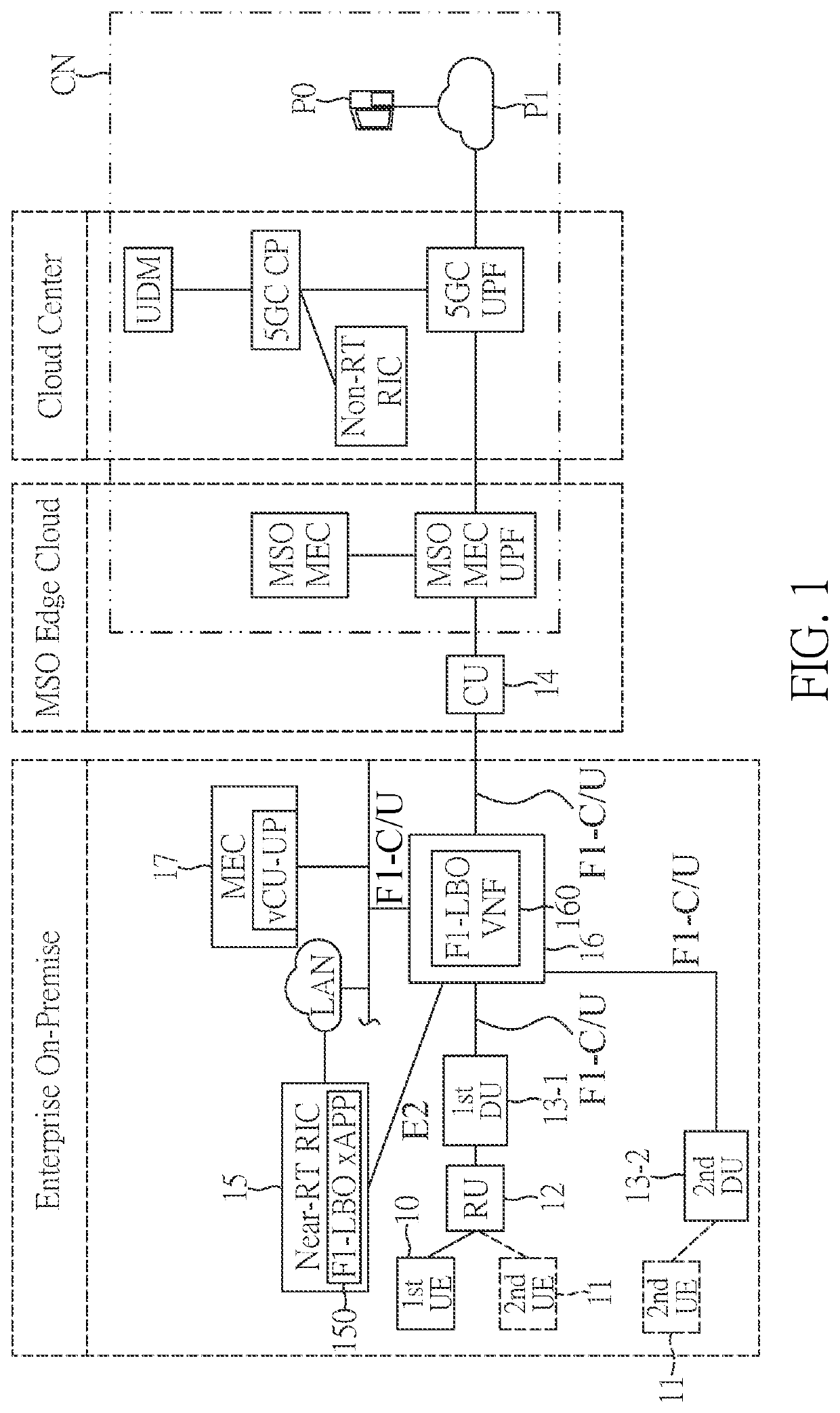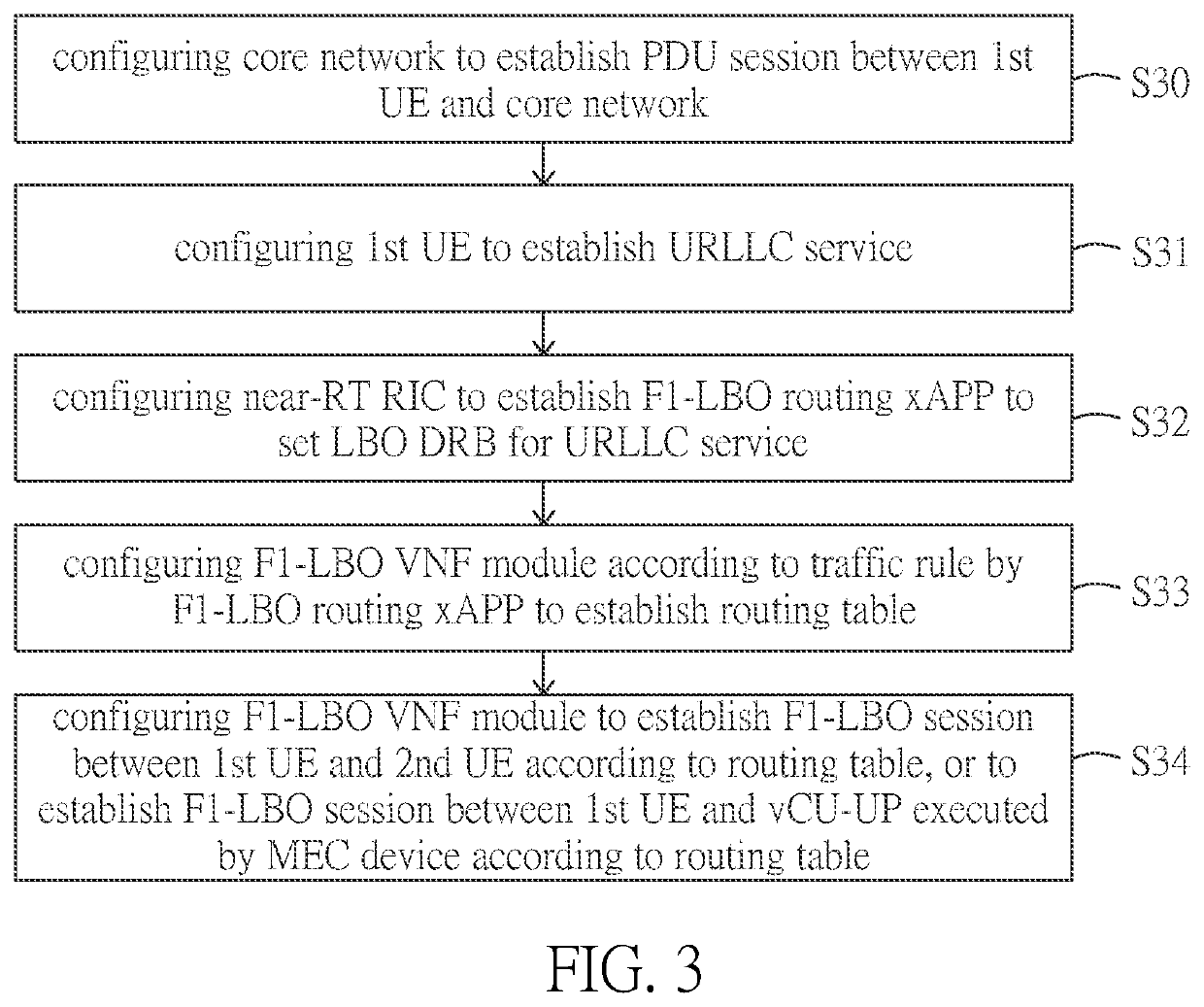Ultra-reliable and low latency communications local breakout method and system for next generation radio access network
a radio access network and low latency technology, applied in the field of ultra-reliable and low latency communications local breakout (urllclbo) method and urllclbo system for a next-generation radio access network, can solve the problems of inconvenient high-synchronization demand services such as smart factories or smart transportation, and the current standard specifications do not support a standard f1-lbo
- Summary
- Abstract
- Description
- Claims
- Application Information
AI Technical Summary
Benefits of technology
Problems solved by technology
Method used
Image
Examples
first embodiment
[0026]Reference is also made to FIG. 2, which is a schematic diagram of an open-radio access network (O-RAN) architecture according to the present disclosure. In short, the system and method provided by the present disclosure are mainly based on a 5G O-RAN architecture. In the past, technical difficulties of 2G / 3G access networks were relatively low, and 2G / 3G access networks were usually integrated and built into the same architecture. As for 5G, a three-tier architecture of RU, DU, and CU is defined. The standardization of the three-tier architecture is called an O-CU, an O-DU, and an O-RU by the O-RAN alliance. In FIG. 2, a prefix “O-” of each element (CU, DU, RU) of a 3GPP architecture represents that it supports newly added interfaces and functions of O-RAN.
[0027]It should be noted that the devices, units, networks, modules, and gateways mentioned in the present disclosure can all be implemented in the form of hardware, software or firmware. When the devices, units, networks, m...
second embodiment
[0053]In the second embodiment, despite the lack of the F1 gateway 16 that can implement a scalability of the F1-LBO among the plurality of DUs, the first DU 13-1 can still be used to implement the F1-LBO shortcut that can be provided by the F1 LBO VNF module 160.
[0054]Therefore, the second embodiment of the present disclosure can meet the O-RAN working group 3 near-RT RIC management interface standard without modifying the original network equipment and UE.
[0055]In addition, the second embodiment can also maintain the original PDN session when the F1-LBO mechanism is provided. Reference is further made to FIG. 6, which is a flowchart of a connection maintaining mechanism according to the second embodiment of the present disclosure.
[0056]As shown in FIG. 6, after the first DU 13-1 executes the F1 LBO VNF module 160 to establish the F1-LBO session, the connection maintaining mechanism can perform the following step:
[0057]Step S60: configuring the first DU 13 to transmit a keep-alive ...
third embodiment
[0059]Reference is further made to FIGS. 2 and 7. FIG. 7 is a flowchart of establishing a routing table of the DRB through the near-RT RIC according to the present disclosure. As shown in FIGS. 2 and 7, the following descriptions further provide the detailed flow of establishing the routing table of the LBO DRB, and the flow includes the following steps:
[0060]Step S70: configuring a non-RT RIC under an SMO device to transmit an LBO policy including the first location and the second location to the near-RT RIC. As previously exemplified, depending on the requirements of the URLLC service, the first location can be a first TEID of the first UE 10, and the second location can be set according to the target of the URLLC service, for example, the second location can be the second TEID of the second UE 11, or can be an IP address of the MEC device 17, and the LBO policy can plan an LBO path from the first location to the second location.
[0061]In response to receiving the LBO policy, the f...
PUM
 Login to View More
Login to View More Abstract
Description
Claims
Application Information
 Login to View More
Login to View More - R&D
- Intellectual Property
- Life Sciences
- Materials
- Tech Scout
- Unparalleled Data Quality
- Higher Quality Content
- 60% Fewer Hallucinations
Browse by: Latest US Patents, China's latest patents, Technical Efficacy Thesaurus, Application Domain, Technology Topic, Popular Technical Reports.
© 2025 PatSnap. All rights reserved.Legal|Privacy policy|Modern Slavery Act Transparency Statement|Sitemap|About US| Contact US: help@patsnap.com



